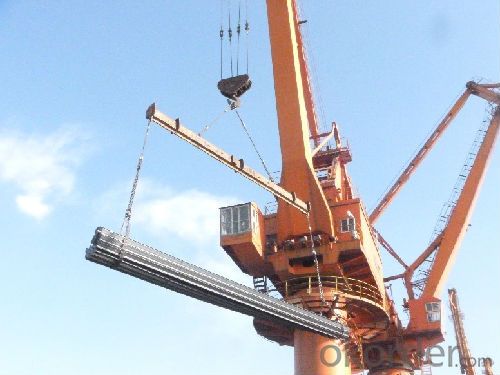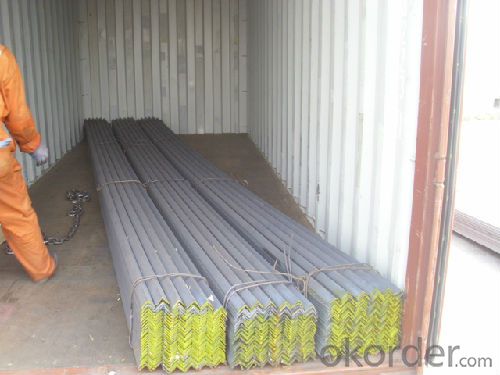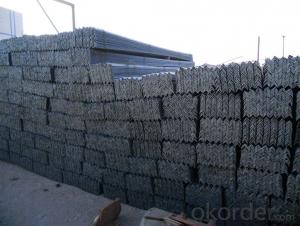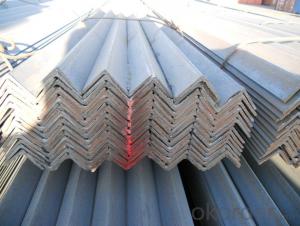Hot Rolled Steel Equal and Unequal Angle Bars
- Loading Port:
- Tianjin
- Payment Terms:
- TT or LC
- Min Order Qty:
- 100 m.t.
- Supply Capability:
- 20000 m.t./month
OKorder Service Pledge
OKorder Financial Service
You Might Also Like
OKorder is offering Hot Rolled Steel Equal and Unequal Angle Bars at great prices with worldwide shipping. Our supplier is a world-class manufacturer of steel, with our products utilized the world over. OKorder annually supplies products to African, South American and Asian markets. We provide quotations within 24 hours of receiving an inquiry and guarantee competitive prices.
Product Applications:
Hot Rolled Steel Equal and Unequal Angle Bars are ideal for structural applications and are widely used in the construction of buildings and bridges, and the manufacturing, petrochemical, and transportation industries
Product Advantages:
OKorder's Hot Rolled Steel Equal and Unequal Angle Bars are durable, strong, and wide variety of sizes.
Main Product Features:
· Premium quality
· Prompt delivery & seaworthy packing (30 days after receiving deposit)
· Can be recycled and reused
· Mill test certification
· Professional Service
· Competitive pricing
Product Specifications:
Manufacture: Hot rolled
Grade: Q195 – 235
Certificates: ISO, SGS, BV, CIQ
Length: 6m – 12m, as per customer request
Packaging: Export packing, nude packing, bundled
| EQUAL ANGLE STEEL | |||||
| size(mm) | a(mm) | a1(mm) | thickness(mm) | kg/m | length |
| 50*50*4 | 50 | 50 | 4 | 3.059 | 6m,9m,12m |
| 50*50*5 | 50 | 50 | 5 | 3.77 | 6m,9m,12m |
| 50*50*6 | 50 | 50 | 6 | 4.465 | 6m,9m,12m |
| 63*63*5 | 63 | 63 | 5 | 4.822 | 6m,9m,12m |
| 63*63*6 | 63 | 63 | 6 | 5.721 | 6m,9m,12m |
| 65*65*5 | 65 | 65 | 5 | 5 | 6m,9m,12m |
| 65*65*6 | 65 | 65 | 6 | 5.91 | 6m,9m,12m |
| 65*65*8 | 65 | 65 | 8 | 7.66 | 6m,9m,12m |
| 75*75*5 | 75 | 75 | 5 | 5.818 | 6m,9m,12m |
| 75*75*6 | 75 | 75 | 6 | 6.905 | 6m,9m,12m |
| 75*75*8 | 75 | 75 | 8 | 9.03 | 6m,9m,12m |
| 75*75*9 | 75 | 75 | 9 | 9.96 | 6m,9m,12m |
| 75*75*10 | 75 | 75 | 10 | 11.089 | 6m,9m,12m |
| 80*80*6 | 80 | 80 | 6 | 7.375 | 6m,9m,12m |
| 80*80*7 | 80 | 80 | 7 | 8.525 | 6m,9m,12m |
| 80*80*8 | 80 | 80 | 8 | 9.658 | 6m,9m,12m |
| 80*80*10 | 80 | 80 | 10 | 11.874 | 6m,9m,12m |
| 90*90*6 | 90 | 90 | 6 | 8.35 | 6m,9m,12m |
| 90*90*7 | 90 | 90 | 7 | 9.656 | 6m,9m,12m |
| 90*90*8 | 90 | 90 | 8 | 10.946 | 6m,9m,12m |
| 90*90*10 | 90 | 90 | 10 | 13.476 | 6m,9m,12m |
| 100*100*6 | 100 | 100 | 6 | 9.366 | 6m,9m,12m |
| 100*100*7 | 100 | 100 | 7 | 10.83 | 6m,9m,12m |
| 100*100*8 | 100 | 100 | 8 | 12.276 | 6m,9m,12m |
| 100*100*9 | 100 | 100 | 9 | 13.49 | 6m,9m,12m |
| 100*100*10 | 100 | 100 | 10 | 15.12 | 6m,9m,12m |
| 100*100*12 | 100 | 100 | 12 | 17.898 | 6m,9m,12m |
| 120*120*8 | 120 | 120 | 8 | 14.88 | 6m,9m,12m |
| 120*120*10 | 120 | 120 | 10 | 18.37 | 6m,9m,12m |
| 120*120*12 | 120 | 120 | 12 | 21.66 | 6m,9m,12m |
| 125*125*8 | 125 | 125 | 8 | 15.504 | 6m,9m,12m |
| 125*125*10 | 125 | 125 | 10 | 19.133 | 6m,9m,12m |
| 125*125*12 | 125 | 125 | 12 | 22.696 | 6m,9m,12m |
| 130*130*10 | 130 | 130 | 10 | 19.8 | 6m,9m,12m |
| 130*130*12 | 130 | 130 | 12 | 23.6 | 6m,9m,12m |
| 130*130*13 | 130 | 130 | 13 | 25.4 | 6m,9m,12m |
| 130*130*14 | 130 | 130 | 14 | 27.2 | 6m,9m,12m |
| 150*150*10 | 150 | 150 | 10 | 23 | 6m,9m,12m |
| 150*150*12 | 150 | 150 | 12 | 27.3 | 6m,9m,12m |
| 150*150*14 | 150 | 150 | 14 | 31.6 | 6m,9m,12m |
| 150*150*15 | 150 | 150 | 15 | 33.8 | 6m,9m,12m |
| 140*140*10 | 140 | 140 | 10 | 21.49 | 6m,9m,12m |
| 140*140*12 | 140 | 140 | 12 | 25.52 | 6m,9m,12m |
| 140*140*14 | 140 | 140 | 14 | 29.49 | 6m,9m,12m |
| 160*160*10 | 160 | 160 | 10 | 24.73 | 6m,9m,12m |
| 160*160*12 | 160 | 160 | 12 | 29.39 | 6m,9m,12m |
| 160*160*14 | 160 | 160 | 14 | 33.99 | 6m,9m,12m |
| 180*180*12 | 180 | 180 | 12 | 33.16 | 6m,9m,12m |
| 180*180*14 | 180 | 180 | 14 | 39.39 | 6m,9m,12m |
| 180*180*16 | 180 | 180 | 16 | 43.45 | 6m,9m,12m |
| 180*180*18 | 180 | 180 | 18 | 48.63 | 6m,9m,12m |
| 200*200*14 | 200 | 200 | 14 | 42.89 | 6m,9m,12m |
| 200*200*16 | 200 | 200 | 16 | 48.68 | 6m,9m,12m |
| 200*200*18 | 200 | 200 | 18 | 54.4 | 6m,9m,12m |
| 200*200*20 | 200 | 200 | 20 | 60.06 | 6m,9m,12m |
| 200*200*24 | 200 | 200 | 24 | 71.17 | 6m,9m,12m |
| UNEQUAL ANGLE STEEL | |||||
| size(mm) | a(mm) | a1(mm) | thickness(mm) | kg/m | length(m) |
| 75*50*5 | 75 | 50 | 5 | 4.808 | 6m,9m,12m |
| 75*50*6 | 75 | 50 | 6 | 5.699 | 6m,9m,12m |
| 75*50*8 | 75 | 50 | 8 | 7.431 | 6m,9m,12m |
| 100*75*7 | 100 | 75 | 7 | 9.34 | 6m,9m,12m |
| 100*75*8 | 100 | 75 | 8 | 10.6 | 6m,9m,12m |
| 100*75*9 | 100 | 75 | 9 | 11.8 | 6m,9m,12m |
| 100*75*10 | 100 | 75 | 10 | 13 | 6m,9m,12m |
| 100*75*12 | 100 | 75 | 12 | 15.4 | 6m,9m,12m |
| 125*75*7 | 125 | 75 | 7 | 10.7 | 6m,9m,12m |
| 125*75*8 | 125 | 75 | 8 | 12.2 | 6m,9m,12m |
| 125*75*9 | 125 | 75 | 9 | 13.6 | 6m,9m,12m |
| 125*75*10 | 125 | 75 | 10 | 15 | 6m,9m,12m |
| 125*75*12 | 125 | 75 | 12 | 17.8 | 6m,9m,12m |
| 150*90*8 | 150 | 90 | 8 | 14.7 | 6m,9m,12m |
| 150*90*9 | 150 | 90 | 9 | 16.4 | 6m,9m,12m |
| 150*90*10 | 150 | 90 | 10 | 18.2 | 6m,9m,12m |
| 150*90*12 | 150 | 90 | 12 | 21.6 | 6m,9m,12m |
| 200*100*10 | 200 | 100 | 10 | 23 | 6m,9m,12m |
| 200*100*12 | 200 | 100 | 12 | 27.62 | 6m,9m,12m |
| 200*100*15 | 200 | 100 | 15 | 34.04 | 6m,9m,12m |
FAQ:
Q1: Why buy Materials & Equipment from OKorder.com?
A1: All products offered byOKorder.com are carefully selected from China's most reliable manufacturing enterprises. Through its ISO certifications, OKorder.com adheres to the highest standards and a commitment to supply chain safety and customer satisfaction.
Q2: How do we guarantee the quality of our products?
A2: We have established an advanced quality management system which conducts strict quality tests at every step, from raw materials to the final product. At the same time, we provide extensive follow-up service assurances as required.
Q3: How soon can we receive the product after purchase?
A3: Within three days of placing an order, we will arrange production. The normal sizes with the normal grade can be produced within one month. The specific shipping date is dependent upon international and government factors, the delivery to international main port about 45-60days.
Q4: How many tons of steel products could be loaded in containers?
A4: Usually the steel products are delivered by bulk vessel because of the large quantity and the freight. However, there are no bulk vessel enter some seaports so that we have to deliver the cargo by containers. The 6m steel product can be loaded in 20FT container, but the quantity is changed according to the size, usually from 18tons to 25tons.
Images:


- Q:Can steel angles be used as supports for mechanical or electrical equipment?
- Indeed, mechanical or electrical equipment can be supported by steel angles. Due to their versatility and strength, steel angles are apt for a diverse array of uses. They offer stability, rigidity, and support, effectively securing mechanical or electrical equipment. The L-shaped configuration of steel angles facilitates effortless attachment and installation, rendering them convenient for a multitude of mounting necessities. Moreover, steel angles can be readily tailored and fabricated to fulfill precise specifications, guaranteeing a dependable and trustworthy support system for the equipment.
- Q:Can steel angles be used for mezzanines or catwalks?
- Mezzanines or catwalks can indeed utilize steel angles. The popularity of steel angles in these applications stems from their strength and versatility. They offer structural support and can be effortlessly bolted or welded together, forming a robust framework for mezzanines or catwalks. Furthermore, steel angles come in different sizes and thicknesses, enabling customization to fulfill specific design needs. In general, steel angles present a cost-efficient and dependable option for constructing mezzanines or catwalks in both commercial and industrial environments.
- Q:What are the different types of steel angles used in transmission line towers?
- Transmission line towers commonly utilize various types of steel angles to provide structural support and stability. These angles are specifically designed to withstand the weight of the transmission lines and the environmental conditions they are exposed to, ensuring the tower's durability. 1. Equal leg angle: This angle features two legs of equal length, forming a right angle. Its simple design and easy fabrication make it a widely used choice in transmission line towers. 2. Unequal leg angle: In this type of angle, the legs have unequal lengths, creating an acute or obtuse angle. Unequal leg angles are employed in transmission line towers that require specific load-bearing capabilities. 3. Bulb angle: Characterized by a bulbous end, bulb angles offer additional strength and stability. They are commonly used in critical areas of transmission line towers, such as the base or connection points, where extra support is needed. 4. Lipped angle: Lipped angles have an extended lip on one side, increasing their load-bearing capacity. They are commonly employed in transmission line towers that require enhanced strength and stability. 5. Back-to-back angle: Back-to-back angles consist of two equal leg angles joined with their flanges touching. This configuration creates a wider angle, providing improved load-bearing capabilities and resistance to bending. It is often selected for transmission line towers that need to support higher loads or longer spans. Each type of steel angle has its own unique characteristics and advantages, allowing engineers to select the most suitable angle for the specific tower design requirements. Careful consideration of these angles ensures the overall strength, stability, and durability of the transmission line tower, facilitating the reliable and efficient transmission of electricity.
- Q:What are the common sizes of steel angles?
- Common sizes of steel angles vary depending on the specific application and industry. However, some standard sizes for steel angles include 1/2 inch, 3/4 inch, 1 inch, 1 1/2 inch, and 2 inches. These sizes are commonly used in construction, engineering, and manufacturing projects.
- Q:Can steel angles be used in window frames?
- Indeed, window frames can incorporate steel angles. These steel angles find frequent application in construction, offering both structural reinforcement and stability to window frames. They often serve as reinforcements or brackets, connecting the window frame to the wall or other elements of the window system. Steel angles possess remarkable durability, strength, and resistance to corrosion, rendering them an excellent option for window frame construction. Moreover, steel angles can be effortlessly tailored and fabricated to suit various window sizes and designs.
- Q:Can steel angles be used for support columns in building construction?
- Yes, steel angles can be used for support columns in building construction. Steel angles are commonly used in construction due to their strength, durability, and versatility. They provide excellent support and stability when used as columns, especially in small to medium-sized buildings. Additionally, steel angles are easy to fabricate and can be customized to meet specific design requirements. They are also resistant to fire, corrosion, and pests, making them a reliable choice for support columns in building construction.
- Q:What is the typical thickness of the base of a steel angle?
- The typical thickness of the base of a steel angle can vary depending on the specific application and requirements. However, in general, the base thickness of a steel angle commonly ranges from 1/8 inch to 3/8 inch. It is important to note that this range is not exhaustive and there may be cases where the base thickness falls outside of these parameters. Factors such as the size, load-bearing capacity, and intended use of the steel angle will influence the base thickness required for a particular project or structure. Therefore, it is crucial to consult engineering specifications or professional guidance to determine the appropriate base thickness for a steel angle in a specific application.
- Q:How do you determine the axial capacity of a steel angle?
- In order to ascertain the axial capacity of a steel angle, one must consider several factors. First and foremost, it is crucial to determine the yield strength of the steel angle. Typically, this information is provided by the manufacturer and can be found in material specifications. The yield strength denotes the maximum stress that the steel angle can endure without experiencing permanent deformation. Following that, the cross-sectional area of the steel angle must be computed. This can be achieved by measuring the angle's dimensions, such as the thickness and the length of its legs. The cross-sectional area is then obtained by multiplying the thickness by the sum of the two leg lengths. Once the cross-sectional area is ascertained, the axial capacity can be calculated by multiplying the yield strength by the cross-sectional area. This will determine the maximum load that the steel angle can bear in a purely axial direction without failure. It is important to bear in mind that there are additional factors that can impact the axial capacity of a steel angle, including the presence of holes or notches, the slenderness ratio, and the loading conditions. Therefore, it is advisable to consult relevant design codes, standards, or engineering handbooks for more comprehensive guidance and to account for these supplementary factors.
- Q:What is the maximum load capacity for a curved steel angle?
- The maximum load capacity for a curved steel angle would depend on various factors such as the dimensions of the angle, the type of steel used, and the specific application. It is best to consult engineering specifications or consult a structural engineer for an accurate determination of the maximum load capacity.
- Q:How do steel angles perform in saltwater environments?
- Steel angles perform well in saltwater environments due to their high corrosion resistance. The addition of alloying elements, such as chromium and nickel, in the steel composition enhances its resistance to corrosion caused by saltwater exposure. These alloying elements create a protective oxide layer on the surface of the steel, preventing direct contact between the steel and the corrosive saltwater. Additionally, steel angles can be further protected with coatings or galvanization, which provide an additional barrier against saltwater corrosion. Overall, steel angles are a durable and reliable choice for applications in saltwater environments, as they can withstand the harsh conditions and maintain their structural integrity over time.
1. Manufacturer Overview |
|
|---|---|
| Location | |
| Year Established | |
| Annual Output Value | |
| Main Markets | |
| Company Certifications | |
2. Manufacturer Certificates |
|
|---|---|
| a) Certification Name | |
| Range | |
| Reference | |
| Validity Period | |
3. Manufacturer Capability |
|
|---|---|
| a)Trade Capacity | |
| Nearest Port | |
| Export Percentage | |
| No.of Employees in Trade Department | |
| Language Spoken: | |
| b)Factory Information | |
| Factory Size: | |
| No. of Production Lines | |
| Contract Manufacturing | |
| Product Price Range | |
Send your message to us
Hot Rolled Steel Equal and Unequal Angle Bars
- Loading Port:
- Tianjin
- Payment Terms:
- TT or LC
- Min Order Qty:
- 100 m.t.
- Supply Capability:
- 20000 m.t./month
OKorder Service Pledge
OKorder Financial Service
Similar products
New products
Hot products
Hot Searches
Related keywords



























